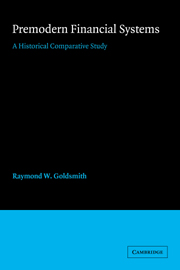Book contents
- Frontmatter
- Contents
- List of tables
- Preface
- 1 Introduction
- 2 The financial systems of the ancient Near East
- 3 The financial system of Periclean Athens
- 4 The financial system of Augustan Rome
- 5 The financial system of the early Abbasid caliphate
- 6 The financial system of the Ottoman Empire at the death of Suleiman I
- 7 The financial system of Mughal India at the death of Akbar
- 8 The financial system of early Tokugawa Japan
- 9 The financial system of Medici Florence
- 10 The financial system of Elizabethan England
- 11 The financial system of the United Provinces at the Peace of Münster
- 12 Similarities and differences
- Notes
- Bibliography
- Index
10 - The financial system of Elizabethan England
Published online by Cambridge University Press: 05 March 2012
- Frontmatter
- Contents
- List of tables
- Preface
- 1 Introduction
- 2 The financial systems of the ancient Near East
- 3 The financial system of Periclean Athens
- 4 The financial system of Augustan Rome
- 5 The financial system of the early Abbasid caliphate
- 6 The financial system of the Ottoman Empire at the death of Suleiman I
- 7 The financial system of Mughal India at the death of Akbar
- 8 The financial system of early Tokugawa Japan
- 9 The financial system of Medici Florence
- 10 The financial system of Elizabethan England
- 11 The financial system of the United Provinces at the Peace of Münster
- 12 Similarities and differences
- Notes
- Bibliography
- Index
Summary
Economically, and even more financially, England at the death of Queen Elizabeth, and certainly at her accession in 1558, was closer to the situation in the later Middle Ages of the fifteenth century than to that in the mid-eighteenth century after the overseas expansion and the “financial revolution” involving in particular the creation of a large tradeable public debt, a central bank issuing paper currency, and a number of joint stock companies of substantial size.
Population
The population of England continued the fairly rapid growth, which had started around 1400 after the reductions reflecting the Black Death, throughout the Elizabethan period and until the mid-seventeenth century. Between 1558 and 1603 it increased by 35 percent or at an annual average rate of nearly 0.7 percent to reach at the death of Elizabeth a level of about 4.5 million or about 30 inhabitants per km2. The increase by about 1.2 million was the result of crude birth rates of about 3.5 percent, death rates of about 2.5 percent, and a small net outward migration of about 0.1 percent. Expectation of life at birth averaged slightly over 35 years. In 1601, 60 percent of the population are estimated to have been in the 15–60 years group with 33 percent below 15 years and only 7 percent above 60 years and a dependency ratio of 0.7.
- Type
- Chapter
- Information
- Premodern Financial SystemsA Historical Comparative Study, pp. 171 - 197Publisher: Cambridge University PressPrint publication year: 1987



